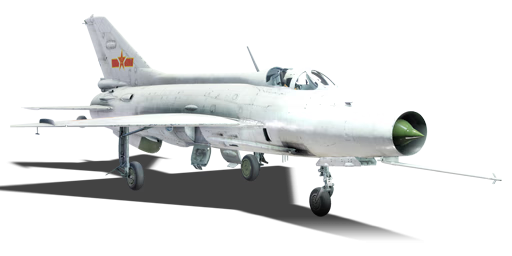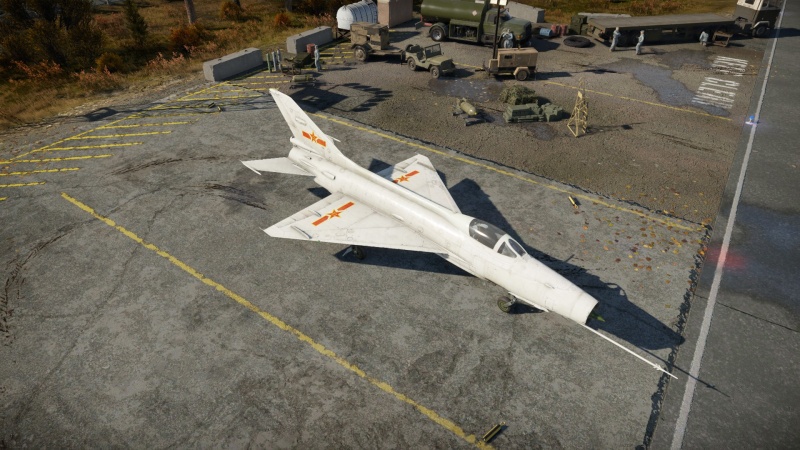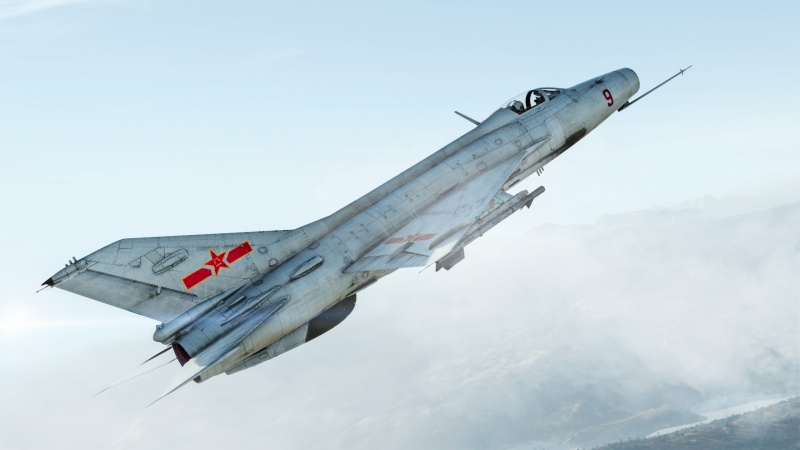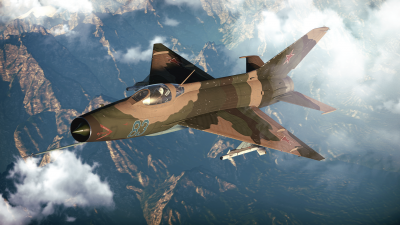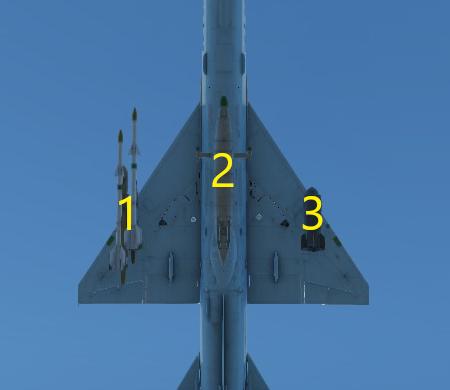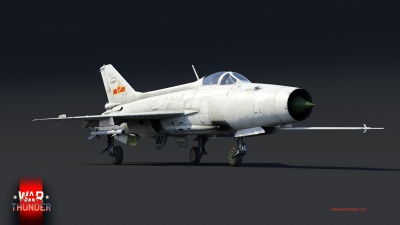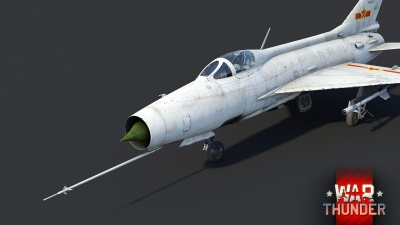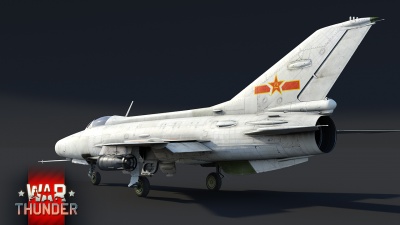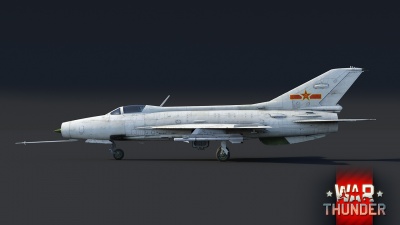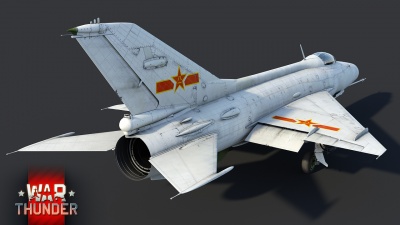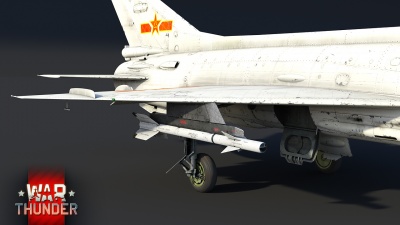Difference between revisions of "J-7II"
m (→Details) |
m (Corrected grammar) |
||
| (17 intermediate revisions by 8 users not shown) | |||
| Line 6: | Line 6: | ||
{{Specs-Card | {{Specs-Card | ||
|code=j_7_mk2 | |code=j_7_mk2 | ||
| − | |images={{Specs-Card-Image|GarageImage_{{PAGENAME}}.jpg}} | + | |images={{Specs-Card-Image|GarageImage_{{PAGENAME}}.jpg|J-7II WebsiteImage 1.jpg}} |
}} | }} | ||
| Line 13: | Line 13: | ||
The '''{{Specs|name}}''' is a rank {{Specs|rank}} Chinese jet fighter {{Battle-rating}}. It was introduced in [[Update 1.91 "Night Vision"]]. | The '''{{Specs|name}}''' is a rank {{Specs|rank}} Chinese jet fighter {{Battle-rating}}. It was introduced in [[Update 1.91 "Night Vision"]]. | ||
| − | After the Korean War, several nations came out with various aircraft which would out-fly opposing aircraft, especially in a dogfight. The U.S. introduced the Lockheed F-104 Starfighter and Northrop F-5 Freedom Fighter while European nations France, England and Sweden rolled out the Dassault Mirage F-1, Mirage III, English Electric Lightning, Hawker Hunter and the Saab Draken. At this time the Soviet Union was working on further developing the twin-engine MiG-19 but realized what it actually needed was a fast, single-engine light-weight fighter in what ultimately became the most highly produced supersonic fighter in the world and used by over 60 countries. | + | After the Korean War, several nations came out with various aircraft which would out-fly opposing aircraft, especially in a dogfight. The U.S. introduced the Lockheed F-104 Starfighter and Northrop F-5 Freedom Fighter while European nations France, England and Sweden rolled out the Dassault Mirage F-1, Mirage III, English Electric Lightning, Hawker Hunter and the Saab Draken. At this time the Soviet Union was working on further developing the twin-engine MiG-19 but realized what it actually needed was a fast, single-engine light-weight fighter in what ultimately became the most highly produced supersonic fighter in the world and used by over 60 countries. The basis of this fighter was the Ye-66a (''Ye'' stands for "Yedinitsa" or single-unit), later changed to MiG-21 F-13 or as dubbed by NATO, the ''Fishbed-C''. Due to a shaky political situation, the Chengdu Aircraft Company in China reverse engineered the MiG-21 sent by the Soviet Union without technological documents. In the process, they solved almost 250 inherent problems with the MiG-21, upgraded the fuel system, replaced the ejection seat and reoriented how the cockpit canopy opened. The result was the J-7 interceptor fighter that looked like the original MiG-21 with minor design and performance differences. NATO dubbed this aircraft ''Fishcan''. |
[[File:MiG-21_smigol_chat_bann.png|400px|thumb|left|Though the '''{{PAGENAME}}''' looks almost exactly the same as the MiG-21 pictured here, the Chinese made many improvements when reverse-engineering the aircraft.]] | [[File:MiG-21_smigol_chat_bann.png|400px|thumb|left|Though the '''{{PAGENAME}}''' looks almost exactly the same as the MiG-21 pictured here, the Chinese made many improvements when reverse-engineering the aircraft.]] | ||
| − | The {{PAGENAME}} was built to be a point defence interceptor, not an air-defence fighter slated for combat missions, basically a short-range day fighter. Due to being cheap, fast, inexpensive and simple to maintain, the essence of this fighter's existence was to be used in large groups to overcome the technologically advanced Western aircraft. Essentially it was a missile which houses a pilot, two 30 mm | + | The {{PAGENAME}} was built to be a point defence interceptor, not an air-defence fighter slated for combat missions, basically a short-range day fighter. Due to being cheap, fast, inexpensive and simple to maintain, the essence of this fighter's existence was to be used in large groups to overcome the technologically advanced Western aircraft. Essentially it was a missile which houses a pilot, two 30 mm cannons and two PL-2 air-to-air missiles. The sleek airframe was made with aluminium alloys, steel, magnesium and fibreglass. The air-intake cone automatically adjusts during the flight to help the aircraft remain aerodynamic. The fighter sported a delta wing with a 57° leading edge and even the all-moving tailplane utilizes the swept feature. Everything about this jet focus on speed which lends it reaching out to the Mach 2 range. The strength of the aircraft is its speed in a straight line whether in a climb, level flight or a dive, however, when it turns at all, it haemorrhages its energy and when it gets below 700 km/h, it is difficult to get back up to speed without diving to make up that speed. When caught near the ground and going slow will be extremely frustrating for a J-7 pilot. |
| − | The {{PAGENAME}} | + | The {{PAGENAME}} excels in air-to-air combat. Beware of hard banking; while it can slow you enough to get behind an enemy fighter, doing so will drain the plane's energy and let an attacker get their guns or lock their missiles onto you. Maintain your situational awareness at all times. Although this fighter can be outfitted with rockets or 500 kg bombs, these options should be reserved for destroying light ground targets or for Ground Realistic battles. The PL-2 missiles are difficult to use, in contrast to later missiles such as the PL-5. Newer pilots may elect to outfit the HF-4 rockets and use them to go after bombers. With only 120 rounds of 30 mm cannon ammunition between the two cannons, trigger discipline is a must or else you will be waiting often for a reload timer to count down or will be frequently returning to base to reload. |
== General info == | == General info == | ||
| Line 23: | Line 23: | ||
{{Specs-Avia-Flight}} | {{Specs-Avia-Flight}} | ||
<!-- ''Describe how the aircraft behaves in the air. Speed, manoeuvrability, acceleration and allowable loads - these are the most important characteristics of the vehicle.'' --> | <!-- ''Describe how the aircraft behaves in the air. Speed, manoeuvrability, acceleration and allowable loads - these are the most important characteristics of the vehicle.'' --> | ||
| − | Due to the Chengdu {{PAGENAME}} being | + | Due to the Chengdu {{PAGENAME}} being a point-defence fighter, the jet's main purpose is to swiftly interdict enemy aircraft. Having a take-off weight of 9.5 tons and power output from the WP-7b jet engine of 3320 kgf, the J-7 is a rocket compared to other contemporary fighters/interceptor aircraft. The closest comparable aircraft in-game are the Hunter F1, Hunter F.6, and the Super Mystère B2. In terms of engine-to-engine statistics, the Hunter F1 is the most similar plane, with a take-off weight of 9.5 tons and power output from a Rolls-Royce Avon Mk. 113 engine with 3188.1 kgf. Nevertheless, the {{PAGENAME}} is able to fly 1,000 km/h faster than the Hunter F1. |
| − | Manoeuvrability in the J-7, for the most part, is non-existent. Due to the shape of the wings and the aerodynamics of the entire aircraft, it is built mostly for high-speed low-drag in a straight flight and that becomes apparent when it enters into a manoeuvre or a turn where it begins to bleed speed at a horrendous rate. With no adjustment to the throttle, a {{PAGENAME}} can drop from 1,000 | + | Manoeuvrability in the J-7, for the most part, is non-existent. Due to the shape of the wings and the aerodynamics of the entire aircraft, it is built mostly for high-speed low-drag in a straight flight and that becomes apparent when it enters into a manoeuvre or a turn where it begins to bleed speed at a horrendous rate. With no adjustment to the throttle, a {{PAGENAME}} can drop from 1,000 km/h to 600 - 700 km/h when banking. J-7 pilots must take into account when they attempt evasive manoeuvres after a missile is fired at them because they may avoid the missile, but they may also end up flying under 700 km/h which can be difficult to return from if there is no room to dive. The best way to use the {{PAGENAME}} is up at higher altitudes where the jet flies faster and has room to dive if the speed needs to be built up after turning or manoeuvring. |
| − | While the {{PAGENAME}} can be outfitted with 500 kg bombs, adding the extra weight impacts this fighter even more. With the bombs placed on under-wing pylons, it decreases the roll | + | While the {{PAGENAME}} can be outfitted with 500 kg bombs, adding the extra weight impacts this fighter even more. With the bombs placed on under-wing pylons, it decreases the roll rate of the aircraft having that weight away from the centre of the aircraft (or in comparison to a clean aircraft – without bombs). Bombs are an option for the aircraft, however, due to needing to maintain speeds above 700 km/h using the J-7 as a bomber is less effective and can expose this aircraft to other fighters who prey on low and slow aircraft. |
{| class="wikitable" style="text-align:center" width="70%" | {| class="wikitable" style="text-align:center" width="70%" | ||
| Line 43: | Line 43: | ||
|- | |- | ||
! Upgraded | ! Upgraded | ||
| − | |2,314||2,262||31.7||33.0||158.1||135.0 | + | | 2,314 || 2,262 || 31.7 || 33.0 || 158.1 || 135.0 |
|- | |- | ||
|} | |} | ||
| Line 101: | Line 101: | ||
! 9m fuel || 20m fuel || 30m fuel | ! 9m fuel || 20m fuel || 30m fuel | ||
|- | |- | ||
| − | | 1, | + | | 1,190 kg || colspan="2" | Afterburning axial-flow turbojet |
| 6,106 kg || 6,817 kg || 7,464 kg || 9,500 kg | | 6,106 kg || 6,817 kg || 7,464 kg || 9,500 kg | ||
|- | |- | ||
| Line 128: | Line 128: | ||
* 65 mm Bulletproof glass – forward canopy windscreen | * 65 mm Bulletproof glass – forward canopy windscreen | ||
| − | With the {{PAGENAME}} configured for and operated as an interceptor, not much thought was put into protecting the aircraft as it was relatively cheap and easy to build and maintain. However, protections were put in place for the pilot which on the other hand was a valuable asset. Protective steel behind the seat and pilot's headrest along with the 65 mm bulletproof glass helped protect the pilot from defensive fire coming from bomber turrets or from smaller calibre guns found on many Western fighters of the time. | + | With the {{PAGENAME}} configured for and operated as an interceptor, not much thought was put into protecting the aircraft as it was relatively cheap and easy to build and maintain. However, protections were put in place for the pilot which on the other hand was a valuable asset. Protective steel behind the seat and the pilot's headrest along with the 65 mm bulletproof glass helped protect the pilot from defensive fire coming from bomber turrets or from smaller calibre guns found on many Western fighters of the time. |
| − | The {{PAGENAME}}'s role as an interceptor basically had it scramble from the airfield when enemy fighters/bombers entered the area and it went full afterburner to reach attack altitude where it would make several passes, down the aircraft and return to the airfield. Due to its speed and limited weapon load-out, further protections for the aircraft's critical component were not necessary and thus left off the aircraft to allow for its | + | The {{PAGENAME}}'s role as an interceptor basically had it scramble from the airfield when enemy fighters/bombers entered the area and it went full afterburner to reach attack altitude where it would make several passes, down the aircraft and return to the airfield. Due to its speed and limited weapon load-out, further protections for the aircraft's critical component were not necessary and thus left off the aircraft to allow for its lightweight and quick intercept capability. |
=== Modifications and economy === | === Modifications and economy === | ||
| Line 146: | Line 146: | ||
* 2 x 30 mm Type 30-1 cannons, belly-mounted (60 rpg = 120 total) | * 2 x 30 mm Type 30-1 cannons, belly-mounted (60 rpg = 120 total) | ||
| − | The {{PAGENAME}} has been outfitted with dual 30 mm Type 30-1 cannons (Chinese version of [[NR-30 (30 mm)|Nudelman-Rikhter NR-30]] cannon). This gun is the perfect weapon for an interceptor class aircraft as it is large enough calibre to do some serious damage, however, this cannon only houses 60 rounds of ammunition per gun. While the small ammunition pool appears to be a negative point to the aircraft, minimizing weight is necessary to ensure this aircraft can intercept inbound enemy aircraft. Compared to the MiG-21 F-13, the {{PAGENAME}} has a second cannon and double the ammunition (60 | + | The {{PAGENAME}} has been outfitted with dual 30 mm Type 30-1 cannons (Chinese version of [[NR-30 (30 mm)|Nudelman-Rikhter NR-30]] cannon). This gun is the perfect weapon for an interceptor class aircraft as it is large enough calibre to do some serious damage, however, this cannon only houses 60 rounds of ammunition per gun. While the small ammunition pool appears to be a negative point to the aircraft, minimizing weight is necessary to ensure this aircraft can intercept inbound enemy aircraft. Compared to the MiG-21 F-13, the {{PAGENAME}} has a second cannon and double the ammunition (60 rpg), however, trigger control is still a necessary skill the pilot must use to ensure enough rounds available to make the necessary shots before returning to base to reload. |
=== Suspended armament === | === Suspended armament === | ||
{{Specs-Avia-Suspended}} | {{Specs-Avia-Suspended}} | ||
<!-- ''Describe the aircraft's suspended armament: additional cannons under the wings, bombs, rockets and torpedoes. This section is especially important for bombers and attackers. If there is no suspended weaponry remove this subsection.'' --> | <!-- ''Describe the aircraft's suspended armament: additional cannons under the wings, bombs, rockets and torpedoes. This section is especially important for bombers and attackers. If there is no suspended weaponry remove this subsection.'' --> | ||
| − | |||
The '''''{{PAGENAME}}''''' can be outfitted with the following ordnance: | The '''''{{PAGENAME}}''''' can be outfitted with the following ordnance: | ||
| − | * | + | {| class="wikitable" style="text-align:center" width="100%" |
| + | |- | ||
| + | ! !! width="15%" | 1 !! width="15%" | 2 !! width="15%" | 3 | ||
| + | | rowspan="5" width="25%" | <div class="ttx-image">[[File:Hardpoints_MiG-21_SPS-K_(Germany).png]]</div> | ||
| + | |- | ||
| + | ! [[FAB-500M-54 (500 kg)|500 kg FAB-500M-54]] bombs | ||
| + | | 1 || || 1 | ||
| + | |- | ||
| + | ! [[Type 57-1]] rockets | ||
| + | | 32 || || 32 | ||
| + | |- | ||
| + | ! [[PL-2]] missiles | ||
| + | | 1 || || 1 | ||
| + | |- | ||
| + | ! 490 l drop tanks | ||
| + | | || 1 || | ||
| + | |- | ||
| + | |} | ||
| + | |||
| + | {{Navigation-Start|Default weapon presets}} | ||
| + | {{Navigation-First-Simple-Line}} | ||
| + | * 1 x 490 l drop tank | ||
* 2 x 500 kg FAB-500M-54 bombs (1,000 kg total) | * 2 x 500 kg FAB-500M-54 bombs (1,000 kg total) | ||
| − | |||
* 2 x PL-2 missiles | * 2 x PL-2 missiles | ||
| + | * 64 x Type 57-1 rockets | ||
| + | {{Navigation-End}} | ||
| + | |||
| + | The PL-2 infrared air-to-air missile is the most important ordnance for air combat and should be familiar to users of the previous J-6A. Although it is a primitive weapon that can be easily dodged or flared, it is useful for picking off distracted or stalled targets and can force supersonic enemies to turn and lose speed. For ground attack, the J-7II's suspended armaments are more limited than the original [[MiG-21F-13]]: it does not have napalm bombs, or more importantly, S-24 heavy rockets with ballistic computer assistance. The 57 mm HEAT rockets are inaccurate and deal relatively little damage. Players who find themselves needing to use the J-7II for CAS in Ground RB are better off with the 500 kg unguided bombs, which are nothing fancy but at least pack a punch. | ||
== Usage in battles == | == Usage in battles == | ||
<!-- ''Describe the tactics of playing in the aircraft, the features of using aircraft in a team and advice on tactics. Refrain from creating a "guide" - do not impose a single point of view, but instead, give the reader food for thought. Examine the most dangerous enemies and give recommendations on fighting them. If necessary, note the specifics of the game in different modes (AB, RB, SB).'' --> | <!-- ''Describe the tactics of playing in the aircraft, the features of using aircraft in a team and advice on tactics. Refrain from creating a "guide" - do not impose a single point of view, but instead, give the reader food for thought. Examine the most dangerous enemies and give recommendations on fighting them. If necessary, note the specifics of the game in different modes (AB, RB, SB).'' --> | ||
| − | Just like the MiG-21, the J-7II was designed to be a fighter | + | Just like the MiG-21, the J-7II was designed to be a fighter interceptor and thus all of its design features shape it into virtually a missile with a cockpit. This aircraft wasn't designed to carry the load the [[F-4C]], [[G.91 YS]] or the [[Super Mystere B2]] can carry, but it was built for speed and to bring along the minimal amount of armament to do its job. |
| − | As a fighter | + | As a fighter interceptor, the J-7II needed to get from Point A (the airbase) to Point B (the inbound enemy aircraft) in the shortest amount of time possible, shoot it, and return to base to get ready for the next one. This jet can remain fast if it is flying in a straight line, however, do not try to sustain dogfights in it. It has a high AoA, meaning it bleeds a good amount of speed in hard turns. |
The best use of this aircraft is to utilise its excellent speed and rate of climb and gain altitude and begin to level off when you are either at bomber altitude or just above any enemy fighters flying around. It is here you can use the great [[Boom & Zoom]] qualities of the aircraft and select a target and begin to dive on it. It is during this phase when you can attempt to get a lock with the PL-2 air-to-air missiles and launch it or you can strafe any unwary targets with the pair of 30 mm Type 30-1 autocannons. Extremely short bursts are a must in order to conserve ammunition (60 rpg, only 120 rounds total), but this powerful gun only needs one or two good shots to remove a wing, take out a pilot or disable an engine. Once shots have been taken, regardless of if they hit or missed, engage the afterburner and return to higher altitudes and set up for another Boom & Zoom run. [[Boom & Run]] techniques also work in that you can use the phenomenal speed of the J-7II to outrun just about any aircraft on the map (however beware of the [[F-4C]] which can keep pace if not outrun the J-7II). | The best use of this aircraft is to utilise its excellent speed and rate of climb and gain altitude and begin to level off when you are either at bomber altitude or just above any enemy fighters flying around. It is here you can use the great [[Boom & Zoom]] qualities of the aircraft and select a target and begin to dive on it. It is during this phase when you can attempt to get a lock with the PL-2 air-to-air missiles and launch it or you can strafe any unwary targets with the pair of 30 mm Type 30-1 autocannons. Extremely short bursts are a must in order to conserve ammunition (60 rpg, only 120 rounds total), but this powerful gun only needs one or two good shots to remove a wing, take out a pilot or disable an engine. Once shots have been taken, regardless of if they hit or missed, engage the afterburner and return to higher altitudes and set up for another Boom & Zoom run. [[Boom & Run]] techniques also work in that you can use the phenomenal speed of the J-7II to outrun just about any aircraft on the map (however beware of the [[F-4C]] which can keep pace if not outrun the J-7II). | ||
| − | Options are available to use this aircraft in the role of ground | + | Options are available to use this aircraft in the role of ground attack, however, this may be an extreme challenge, especially to any novice fighter jet pilot. While the 30 mm autocannon is standard in all of the ordnance load-outs, when adding a secondary suspended armament, you are limited to only one type. In this case, you will need to choose from 32 lightweight HF-5 rockets or two 500 kg bombs. The added weight and drag when adding either of these options can be difficult to overcome, especially since this aircraft is built for speed over manoeuvrability. |
| + | |||
| + | When attacking ground targets, it is best to place the J-7II into a relatively shallow dive, it is important to remember to properly line up for the target ahead of time because with the external ordnance fine-tuned manoeuvring can be difficult especially when corrections need to be made at the last minute. The lack of a bombsight makes bombing smaller targets a bit more difficult to hit. When flying low to take on ground targets, make sure you leave yourself an out when the situation turns bad. The best practice here is to ensure you keep your speed up, slow enough to hit the target, but fast enough to get away when the situation turns. | ||
| + | |||
| + | === Radars === | ||
| + | <!--{{main|SRD-5}}--> | ||
| + | The J-7II is equipped with an SRD-5 rangefinding radar, located in the nose of the aircraft. | ||
| + | It will automatically detect other planes within the scanning area and display the range to the closest target. It is linked with a gyro gunsight and can help with aiming at close range. | ||
| − | + | {| class="wikitable" style="text-align:center" | |
| + | ! colspan="4" | SRD-5 - Rangefinding radar | ||
| + | |- | ||
| + | ! {{Annotation|Maximum<br/>Tracking<br/>Range|The maximum range at which a target can be tracked}} | ||
| + | ! {{Annotation|Minimum<br/>Tracking<br/>Range|The range below which targets cannot be tracked by the radar}} | ||
| + | ! {{Annotation|Azimuth Tracking<br/>Angle|How far to each side the radar can track a target}} | ||
| + | ! {{Annotation|Elevation Tracking<br/>Angle|How far up and down the radar can track a target}} | ||
| + | |- | ||
| + | | 3,000 m || 300 m || ±9° || ±9° | ||
| + | |- | ||
| + | |} | ||
=== Pros and cons === | === Pros and cons === | ||
| Line 178: | Line 218: | ||
'''Pros:''' | '''Pros:''' | ||
| − | * | + | * Higher acceleration and speed than its Soviet counterparts thanks to its new engine |
| − | * | + | * Less high-speed compression than the [[J-6A]] |
| + | * Can pull high AoA for quick snapshots | ||
| + | * Additional port side gun which doubled the ammo count than [[MiG-21F-13]] | ||
* Great rate of climb | * Great rate of climb | ||
* Missiles have a high explosive mass | * Missiles have a high explosive mass | ||
| Line 186: | Line 228: | ||
* Not very manoeuvrable at low speeds | * Not very manoeuvrable at low speeds | ||
| − | * Missiles | + | * Loses energy quickly in hard turns |
| + | * Missiles have poor agility and tracking, easily dodged by attentive targets | ||
| + | * Engine tends to overheat on sustained afterburner | ||
| + | * Unlike the MiG-21F-13, no access to S-24 heavy rockets for ground attack or head-ons | ||
| + | * Does not have access to flares, making it hard to operate in up-tiers | ||
== History == | == History == | ||
<!-- ''Describe the history of the creation and combat usage of the aircraft in more detail than in the introduction. If the historical reference turns out to be too long, take it to a separate article, taking a link to the article about the vehicle and adding a block "/History" (example: <nowiki>https://wiki.warthunder.com/(Vehicle-name)/History</nowiki>) and add a link to it here using the <code>main</code> template. Be sure to reference text and sources by using <code><nowiki><ref></ref></nowiki></code>, as well as adding them at the end of the article with <code><nowiki><references /></nowiki></code>. This section may also include the vehicle's dev blog entry (if applicable) and the in-game encyclopedia description (under <code><nowiki>=== In-game description ===</nowiki></code>, also if applicable).'' --> | <!-- ''Describe the history of the creation and combat usage of the aircraft in more detail than in the introduction. If the historical reference turns out to be too long, take it to a separate article, taking a link to the article about the vehicle and adding a block "/History" (example: <nowiki>https://wiki.warthunder.com/(Vehicle-name)/History</nowiki>) and add a link to it here using the <code>main</code> template. Be sure to reference text and sources by using <code><nowiki><ref></ref></nowiki></code>, as well as adding them at the end of the article with <code><nowiki><references /></nowiki></code>. This section may also include the vehicle's dev blog entry (if applicable) and the in-game encyclopedia description (under <code><nowiki>=== In-game description ===</nowiki></code>, also if applicable).'' --> | ||
| − | The Sino-Soviet split, which began in the late 1950s, led to a period of chilled relations between the Soviet Union and the People's Republic of China. The most modern fighter aircraft in the inventory of the People's Liberation Army Air Force was the MiG-19, purchased from the USSR. While an effective fighter at the time of its introduction, rapid advancements in fighter jet development lead to new aircraft like the MiG-21 capable of flying at twice the speed of sound. Around 1960, plans were underway for MiG-21s to be license produced in China, but negotiations broke down and Soviet advisors were pulled from the country, leaving the fate of the project in question. A few years later, Khruschev unexpectedly approached Mao with an offer to sell the MiG-21 and its technology. This deal went through and several MiG-21s, parts, and associated documentation were delivered to China. However, it was discovered that the documents were incomplete. In order to manufacture them properly, the MiG-21s were thoroughly reverse engineered, and a number of improvements were made in the process. The finished product of this effort was | + | The Sino-Soviet split, which began in the late 1950s, led to a period of chilled relations between the Soviet Union and the People's Republic of China. The most modern fighter aircraft in the inventory of the People's Liberation Army Air Force was the MiG-19, purchased from the USSR. While an effective fighter at the time of its introduction, rapid advancements in fighter jet development lead to new aircraft like the MiG-21 capable of flying at twice the speed of sound. Around 1960, plans were underway for MiG-21s to be license produced in China, but negotiations broke down and Soviet advisors were pulled from the country, leaving the fate of the project in question. A few years later, Khruschev unexpectedly approached Mao with an offer to sell the MiG-21 and its technology. This deal went through and several MiG-21s, parts, and associated documentation were delivered to China. However, it was discovered that the documents were incomplete. In order to manufacture them properly, the MiG-21s were thoroughly reverse-engineered, and a number of improvements were made in the process. The finished product of this effort was firstly named a '''Type 62 Interceptor (62式歼击机)''' then later a '''J-7 (歼-7)''', mostly identical to the original [[MiG-21 F-13]] (NATO: Fishbed; the Chinese variants are sometimes called a '''Fishcan''' to differentiate from Soviet-built ones). |
| − | A huge number of J-7 variants were manufactured in the course of its nearly 50-year production run, though development and production stagnated during the chaos of the Cultural Revolution and the PLAAF often had to rely on the outdated [[J-6A|Shenyang J-6]]. The '''{{PAGENAME}}''' first flew in 1978 and featured an improved engine and ejection seat, among other changes. | + | A huge number of J-7 variants were manufactured in the course of its nearly 50-year production run, though development and production stagnated during the chaos of the Cultural Revolution and the PLAAF often had to rely on the outdated [[J-6A|Shenyang J-6]]. The '''{{PAGENAME}}''' first flew in 1978 and featured an improved engine and ejection seat, among other changes. Later J-7B/F-7M incorporated British GEC Marconi avionics and was compatible with Western weapons, these were popular export items to customers like Bangladesh, Pakistan, Nigeria, and Iran. The J-7III series was developed from the basis of a reverse-engineered [[MiG-21MF (Germany)|MiG-21MF]] and attempted to match the MiG-21SM, featuring a larger nosecone and a more powerful radar, but did not see large-scale production. The successful J-7IV (later [[J-7E]]) introduced a unique double-delta wing design that improved the aircraft's agility and fuel capacity tremendously. The J-7 design was also used as a starting point for the Guizhou JL-9 supersonic trainer and the JF-17 multirole export fighter. |
| − | At present the J-7 is still in the inventory of numerous air forces, | + | At present, the J-7 is still in the inventory of numerous air forces, but they are mostly those based on the later E variants (F-7MG, PG, BG) and only very few of the original delta wing variants are still in service. After PLAAF and PLANAF decommissioned their remaining J-7IIH and J-7B from combat service in 2021, the remaining J-7E and G still served as an inexpensive and quick-response frontline interceptors for PLAAF. |
== Media == | == Media == | ||
<!-- ''Excellent additions to the article would be video guides, screenshots from the game, and photos.'' --> | <!-- ''Excellent additions to the article would be video guides, screenshots from the game, and photos.'' --> | ||
| + | |||
| + | ;Skins | ||
| + | |||
| + | * [https://live.warthunder.com/feed/camouflages/?vehicle=j_7_mk2 Skins and camouflages for the {{PAGENAME}} from live.warthunder.com.] | ||
;Images | ;Images | ||
| − | < | + | <gallery mode="packed-hover" heights="150"> |
| − | + | File:J-7 mkII WTWallpaper 001.jpg | |
| − | + | File:J-7 mkII WTWallpaper 002.jpg | |
| − | + | File:J-7 mkII WTWallpaper 003.jpg | |
| − | + | File:J-7 mkII WTWallpaper 004.jpg | |
| − | + | File:J-7 mkII WTWallpaper 005.jpg | |
| − | + | File:J-7 mkII WTWallpaper 006.jpg | |
| − | + | </gallery> | |
| + | |||
| + | ;Videos | ||
| + | {{Youtube-gallery|30XMgpkhDio|'''Chengdu J7 - Superior To The MiG-21 - A Guide''' - ''WhooptieDo''}} | ||
== See also == | == See also == | ||
| − | ''Links to the articles on the War Thunder Wiki that you think will be useful for the reader, for example:'' | + | <!-- ''Links to the articles on the War Thunder Wiki that you think will be useful for the reader, for example:'' |
| + | * ''reference to the series of the aircraft;'' | ||
| + | * ''links to approximate analogues of other nations and research trees.'' --> | ||
| − | * | + | ;Related development |
| − | * | + | |
| + | * [[J-7D]] - Upgraded version based on reverse engineered MiG-21MF (J-7C) | ||
| + | * [[J-7E]] - Double-delta wing version with more advanced avionics | ||
== External links == | == External links == | ||
<!-- ''Paste links to sources and external resources, such as:'' | <!-- ''Paste links to sources and external resources, such as:'' | ||
* ''topic on the official game forum;'' | * ''topic on the official game forum;'' | ||
| − | |||
* ''other literature.'' --> | * ''other literature.'' --> | ||
Latest revision as of 12:46, 19 October 2024
| This page is about the Chinese jet fighter J-7II. For other versions, see MiG-21 (Family). |
Contents
Description
The J-7II is a rank VI Chinese jet fighter with a battle rating of 9.3 (AB/RB) and 9.7 (SB). It was introduced in Update 1.91 "Night Vision".
After the Korean War, several nations came out with various aircraft which would out-fly opposing aircraft, especially in a dogfight. The U.S. introduced the Lockheed F-104 Starfighter and Northrop F-5 Freedom Fighter while European nations France, England and Sweden rolled out the Dassault Mirage F-1, Mirage III, English Electric Lightning, Hawker Hunter and the Saab Draken. At this time the Soviet Union was working on further developing the twin-engine MiG-19 but realized what it actually needed was a fast, single-engine light-weight fighter in what ultimately became the most highly produced supersonic fighter in the world and used by over 60 countries. The basis of this fighter was the Ye-66a (Ye stands for "Yedinitsa" or single-unit), later changed to MiG-21 F-13 or as dubbed by NATO, the Fishbed-C. Due to a shaky political situation, the Chengdu Aircraft Company in China reverse engineered the MiG-21 sent by the Soviet Union without technological documents. In the process, they solved almost 250 inherent problems with the MiG-21, upgraded the fuel system, replaced the ejection seat and reoriented how the cockpit canopy opened. The result was the J-7 interceptor fighter that looked like the original MiG-21 with minor design and performance differences. NATO dubbed this aircraft Fishcan.
The J-7II was built to be a point defence interceptor, not an air-defence fighter slated for combat missions, basically a short-range day fighter. Due to being cheap, fast, inexpensive and simple to maintain, the essence of this fighter's existence was to be used in large groups to overcome the technologically advanced Western aircraft. Essentially it was a missile which houses a pilot, two 30 mm cannons and two PL-2 air-to-air missiles. The sleek airframe was made with aluminium alloys, steel, magnesium and fibreglass. The air-intake cone automatically adjusts during the flight to help the aircraft remain aerodynamic. The fighter sported a delta wing with a 57° leading edge and even the all-moving tailplane utilizes the swept feature. Everything about this jet focus on speed which lends it reaching out to the Mach 2 range. The strength of the aircraft is its speed in a straight line whether in a climb, level flight or a dive, however, when it turns at all, it haemorrhages its energy and when it gets below 700 km/h, it is difficult to get back up to speed without diving to make up that speed. When caught near the ground and going slow will be extremely frustrating for a J-7 pilot.
The J-7II excels in air-to-air combat. Beware of hard banking; while it can slow you enough to get behind an enemy fighter, doing so will drain the plane's energy and let an attacker get their guns or lock their missiles onto you. Maintain your situational awareness at all times. Although this fighter can be outfitted with rockets or 500 kg bombs, these options should be reserved for destroying light ground targets or for Ground Realistic battles. The PL-2 missiles are difficult to use, in contrast to later missiles such as the PL-5. Newer pilots may elect to outfit the HF-4 rockets and use them to go after bombers. With only 120 rounds of 30 mm cannon ammunition between the two cannons, trigger discipline is a must or else you will be waiting often for a reload timer to count down or will be frequently returning to base to reload.
General info
Flight performance
Due to the Chengdu J-7II being a point-defence fighter, the jet's main purpose is to swiftly interdict enemy aircraft. Having a take-off weight of 9.5 tons and power output from the WP-7b jet engine of 3320 kgf, the J-7 is a rocket compared to other contemporary fighters/interceptor aircraft. The closest comparable aircraft in-game are the Hunter F1, Hunter F.6, and the Super Mystère B2. In terms of engine-to-engine statistics, the Hunter F1 is the most similar plane, with a take-off weight of 9.5 tons and power output from a Rolls-Royce Avon Mk. 113 engine with 3188.1 kgf. Nevertheless, the J-7II is able to fly 1,000 km/h faster than the Hunter F1.
Manoeuvrability in the J-7, for the most part, is non-existent. Due to the shape of the wings and the aerodynamics of the entire aircraft, it is built mostly for high-speed low-drag in a straight flight and that becomes apparent when it enters into a manoeuvre or a turn where it begins to bleed speed at a horrendous rate. With no adjustment to the throttle, a J-7II can drop from 1,000 km/h to 600 - 700 km/h when banking. J-7 pilots must take into account when they attempt evasive manoeuvres after a missile is fired at them because they may avoid the missile, but they may also end up flying under 700 km/h which can be difficult to return from if there is no room to dive. The best way to use the J-7II is up at higher altitudes where the jet flies faster and has room to dive if the speed needs to be built up after turning or manoeuvring.
While the J-7II can be outfitted with 500 kg bombs, adding the extra weight impacts this fighter even more. With the bombs placed on under-wing pylons, it decreases the roll rate of the aircraft having that weight away from the centre of the aircraft (or in comparison to a clean aircraft – without bombs). Bombs are an option for the aircraft, however, due to needing to maintain speeds above 700 km/h using the J-7 as a bomber is less effective and can expose this aircraft to other fighters who prey on low and slow aircraft.
| Characteristics | Max Speed (km/h at 13,000 m) |
Max altitude (metres) |
Turn time (seconds) |
Rate of climb (metres/second) |
Take-off run (metres) | |||
|---|---|---|---|---|---|---|---|---|
| AB | RB | AB | RB | AB | RB | |||
| Stock | 2,233 | 2,219 | 16000 | 34.6 | 35.2 | 113.8 | 106.9 | 750 |
| Upgraded | 2,314 | 2,262 | 31.7 | 33.0 | 158.1 | 135.0 | ||
Details
| Features | |||||
|---|---|---|---|---|---|
| Combat flaps | Take-off flaps | Landing flaps | Air brakes | Arrestor gear | Drogue chute |
| X | ✓ | ✓ | ✓ | X | ✓ |
| Limits | ||||||
|---|---|---|---|---|---|---|
| Wings (km/h) | Gear (km/h) | Flaps (km/h) | Max Static G | |||
| Combat | Take-off | Landing | + | - | ||
| 1365 | 500 | N/A | 524 | 450 | ~11 | ~5 |
| Optimal velocities (km/h) | |||
|---|---|---|---|
| Ailerons | Rudder | Elevators | Radiator |
| < 650 | < 600 | < 780 | N/A |
Engine performance
| Engine | Aircraft mass | |||||
|---|---|---|---|---|---|---|
| Engine name | Number | Empty mass | Wing loading (full fuel) | |||
| Shenyang Liming WP-7b | 1 | 5,512 kg | 325 kg/m2 | |||
| Engine characteristics | Mass with fuel (no weapons load) | Max Takeoff Weight | ||||
| Weight (each) | Type | 9m fuel | 20m fuel | 30m fuel | ||
| 1,190 kg | Afterburning axial-flow turbojet | 6,106 kg | 6,817 kg | 7,464 kg | 9,500 kg | |
| Maximum engine thrust @ 0 m (RB / SB) | Thrust to weight ratio @ 0 m (WEP) | |||||
| Condition | 100% | WEP | 9m fuel | 20m fuel | 30m fuel | MTOW |
| Stationary | 3,640 kgf | 5,387 kgf | 0.88 | 0.79 | 0.72 | 0.57 |
| Optimal | 3,640 kgf (0 km/h) |
5,686 kgf (1,200 km/h) |
0.93 | 0.83 | 0.76 | 0.60 |
Survivability and armour
- Armour
- 16 mm Steel – behind the pilot's seat
- 25 mm Steel – pilot's headrest
- 65 mm Bulletproof glass – forward canopy windscreen
With the J-7II configured for and operated as an interceptor, not much thought was put into protecting the aircraft as it was relatively cheap and easy to build and maintain. However, protections were put in place for the pilot which on the other hand was a valuable asset. Protective steel behind the seat and the pilot's headrest along with the 65 mm bulletproof glass helped protect the pilot from defensive fire coming from bomber turrets or from smaller calibre guns found on many Western fighters of the time.
The J-7II's role as an interceptor basically had it scramble from the airfield when enemy fighters/bombers entered the area and it went full afterburner to reach attack altitude where it would make several passes, down the aircraft and return to the airfield. Due to its speed and limited weapon load-out, further protections for the aircraft's critical component were not necessary and thus left off the aircraft to allow for its lightweight and quick intercept capability.
Modifications and economy
Armaments
Offensive armament
The J-7II is armed with:
- 2 x 30 mm Type 30-1 cannons, belly-mounted (60 rpg = 120 total)
The J-7II has been outfitted with dual 30 mm Type 30-1 cannons (Chinese version of Nudelman-Rikhter NR-30 cannon). This gun is the perfect weapon for an interceptor class aircraft as it is large enough calibre to do some serious damage, however, this cannon only houses 60 rounds of ammunition per gun. While the small ammunition pool appears to be a negative point to the aircraft, minimizing weight is necessary to ensure this aircraft can intercept inbound enemy aircraft. Compared to the MiG-21 F-13, the J-7II has a second cannon and double the ammunition (60 rpg), however, trigger control is still a necessary skill the pilot must use to ensure enough rounds available to make the necessary shots before returning to base to reload.
Suspended armament
The J-7II can be outfitted with the following ordnance:
| 1 | 2 | 3 | ||
|---|---|---|---|---|
| 500 kg FAB-500M-54 bombs | 1 | 1 | ||
| Type 57-1 rockets | 32 | 32 | ||
| PL-2 missiles | 1 | 1 | ||
| 490 l drop tanks | 1 |
| Default weapon presets | |
|---|---|
| |
The PL-2 infrared air-to-air missile is the most important ordnance for air combat and should be familiar to users of the previous J-6A. Although it is a primitive weapon that can be easily dodged or flared, it is useful for picking off distracted or stalled targets and can force supersonic enemies to turn and lose speed. For ground attack, the J-7II's suspended armaments are more limited than the original MiG-21F-13: it does not have napalm bombs, or more importantly, S-24 heavy rockets with ballistic computer assistance. The 57 mm HEAT rockets are inaccurate and deal relatively little damage. Players who find themselves needing to use the J-7II for CAS in Ground RB are better off with the 500 kg unguided bombs, which are nothing fancy but at least pack a punch.
Usage in battles
Just like the MiG-21, the J-7II was designed to be a fighter interceptor and thus all of its design features shape it into virtually a missile with a cockpit. This aircraft wasn't designed to carry the load the F-4C, G.91 YS or the Super Mystere B2 can carry, but it was built for speed and to bring along the minimal amount of armament to do its job.
As a fighter interceptor, the J-7II needed to get from Point A (the airbase) to Point B (the inbound enemy aircraft) in the shortest amount of time possible, shoot it, and return to base to get ready for the next one. This jet can remain fast if it is flying in a straight line, however, do not try to sustain dogfights in it. It has a high AoA, meaning it bleeds a good amount of speed in hard turns.
The best use of this aircraft is to utilise its excellent speed and rate of climb and gain altitude and begin to level off when you are either at bomber altitude or just above any enemy fighters flying around. It is here you can use the great Boom & Zoom qualities of the aircraft and select a target and begin to dive on it. It is during this phase when you can attempt to get a lock with the PL-2 air-to-air missiles and launch it or you can strafe any unwary targets with the pair of 30 mm Type 30-1 autocannons. Extremely short bursts are a must in order to conserve ammunition (60 rpg, only 120 rounds total), but this powerful gun only needs one or two good shots to remove a wing, take out a pilot or disable an engine. Once shots have been taken, regardless of if they hit or missed, engage the afterburner and return to higher altitudes and set up for another Boom & Zoom run. Boom & Run techniques also work in that you can use the phenomenal speed of the J-7II to outrun just about any aircraft on the map (however beware of the F-4C which can keep pace if not outrun the J-7II).
Options are available to use this aircraft in the role of ground attack, however, this may be an extreme challenge, especially to any novice fighter jet pilot. While the 30 mm autocannon is standard in all of the ordnance load-outs, when adding a secondary suspended armament, you are limited to only one type. In this case, you will need to choose from 32 lightweight HF-5 rockets or two 500 kg bombs. The added weight and drag when adding either of these options can be difficult to overcome, especially since this aircraft is built for speed over manoeuvrability.
When attacking ground targets, it is best to place the J-7II into a relatively shallow dive, it is important to remember to properly line up for the target ahead of time because with the external ordnance fine-tuned manoeuvring can be difficult especially when corrections need to be made at the last minute. The lack of a bombsight makes bombing smaller targets a bit more difficult to hit. When flying low to take on ground targets, make sure you leave yourself an out when the situation turns bad. The best practice here is to ensure you keep your speed up, slow enough to hit the target, but fast enough to get away when the situation turns.
Radars
The J-7II is equipped with an SRD-5 rangefinding radar, located in the nose of the aircraft. It will automatically detect other planes within the scanning area and display the range to the closest target. It is linked with a gyro gunsight and can help with aiming at close range.
| SRD-5 - Rangefinding radar | |||
|---|---|---|---|
| Maximum Tracking Range |
Minimum Tracking Range |
Azimuth Tracking Angle |
Elevation Tracking Angle |
| 3,000 m | 300 m | ±9° | ±9° |
Pros and cons
Pros:
- Higher acceleration and speed than its Soviet counterparts thanks to its new engine
- Less high-speed compression than the J-6A
- Can pull high AoA for quick snapshots
- Additional port side gun which doubled the ammo count than MiG-21F-13
- Great rate of climb
- Missiles have a high explosive mass
Cons:
- Not very manoeuvrable at low speeds
- Loses energy quickly in hard turns
- Missiles have poor agility and tracking, easily dodged by attentive targets
- Engine tends to overheat on sustained afterburner
- Unlike the MiG-21F-13, no access to S-24 heavy rockets for ground attack or head-ons
- Does not have access to flares, making it hard to operate in up-tiers
History
The Sino-Soviet split, which began in the late 1950s, led to a period of chilled relations between the Soviet Union and the People's Republic of China. The most modern fighter aircraft in the inventory of the People's Liberation Army Air Force was the MiG-19, purchased from the USSR. While an effective fighter at the time of its introduction, rapid advancements in fighter jet development lead to new aircraft like the MiG-21 capable of flying at twice the speed of sound. Around 1960, plans were underway for MiG-21s to be license produced in China, but negotiations broke down and Soviet advisors were pulled from the country, leaving the fate of the project in question. A few years later, Khruschev unexpectedly approached Mao with an offer to sell the MiG-21 and its technology. This deal went through and several MiG-21s, parts, and associated documentation were delivered to China. However, it was discovered that the documents were incomplete. In order to manufacture them properly, the MiG-21s were thoroughly reverse-engineered, and a number of improvements were made in the process. The finished product of this effort was firstly named a Type 62 Interceptor (62式歼击机) then later a J-7 (歼-7), mostly identical to the original MiG-21 F-13 (NATO: Fishbed; the Chinese variants are sometimes called a Fishcan to differentiate from Soviet-built ones).
A huge number of J-7 variants were manufactured in the course of its nearly 50-year production run, though development and production stagnated during the chaos of the Cultural Revolution and the PLAAF often had to rely on the outdated Shenyang J-6. The J-7II first flew in 1978 and featured an improved engine and ejection seat, among other changes. Later J-7B/F-7M incorporated British GEC Marconi avionics and was compatible with Western weapons, these were popular export items to customers like Bangladesh, Pakistan, Nigeria, and Iran. The J-7III series was developed from the basis of a reverse-engineered MiG-21MF and attempted to match the MiG-21SM, featuring a larger nosecone and a more powerful radar, but did not see large-scale production. The successful J-7IV (later J-7E) introduced a unique double-delta wing design that improved the aircraft's agility and fuel capacity tremendously. The J-7 design was also used as a starting point for the Guizhou JL-9 supersonic trainer and the JF-17 multirole export fighter.
At present, the J-7 is still in the inventory of numerous air forces, but they are mostly those based on the later E variants (F-7MG, PG, BG) and only very few of the original delta wing variants are still in service. After PLAAF and PLANAF decommissioned their remaining J-7IIH and J-7B from combat service in 2021, the remaining J-7E and G still served as an inexpensive and quick-response frontline interceptors for PLAAF.
Media
- Skins
- Images
- Videos
See also
- Related development
- J-7D - Upgraded version based on reverse engineered MiG-21MF (J-7C)
- J-7E - Double-delta wing version with more advanced avionics
External links
- [Development] Chengdu J-7II: Domestic Technologies
- Official data sheet - more details about the performance
| Chengdu Aircraft Industry Group (中航工业成都飞机工业集团) | |
|---|---|
| Jet Fighters | |
| J-7 | J-7II* · J-7D · J-7E |
| J-10 | J-10A |
| JF-17 | JF-17** |
| Drones | Wing Loong I |
| *Unlicensed and reverse-engineered version of the MiG-21. | |
| **Jointly developed and built by Chengdu Aircraft Industry Group and Pakistan Aeronautical Complex. | |
| See Also | Mikoyan-Gurevich Design Bureau · Pakistan Aeronautical Complex |
| China jet aircraft | |
|---|---|
| Fighters | J-2 · J-4 · J-6A · J-7II · J-7D · J-7E · J-8B · J-8F · J-10A · J-11 · J-11A |
| Strike aircraft | Q-5 early · Q-5A · Q-5L · JH-7A |
| Bombers | H-5 |
| France | ␗Mirage 2000-5Ei |
| USA | ␗F-84G-21-RE · ␗F-84G-31-RE · ␗F-86F-30 · ␗F-86F-40 · ␗F-100A · ␗F-100F · ␗F-104A · ␗F-104G · ␗F-5A · ␗F-5E · ␗F-16A MLU |
| USSR | ␗MiG-9 · ␗MiG-9 (l) |
| North Korea | Shenyang F-5 |
| Pakistan | A-5C · JF-17 |


